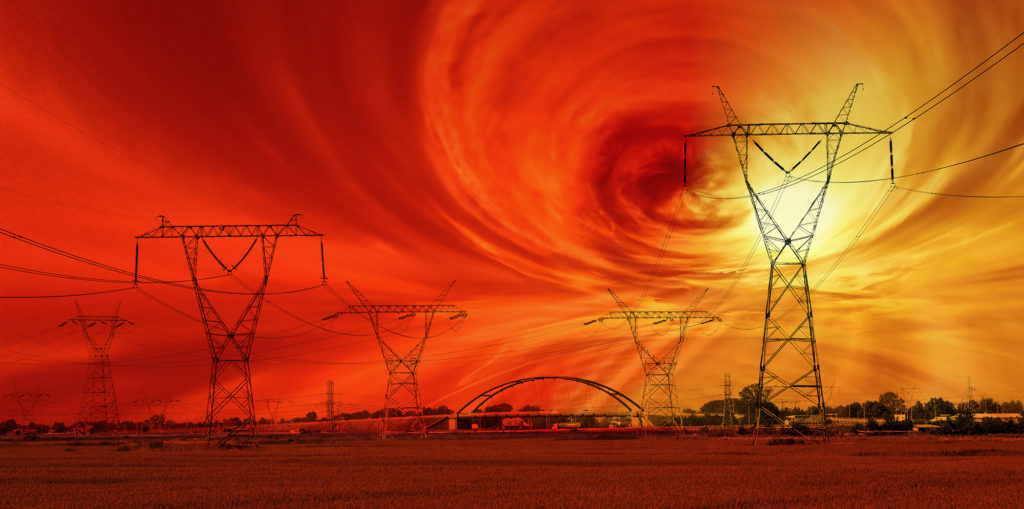EPRI research provides tools and understanding to prepare for 100-year solar storms
People travel thousands of miles to remote spots in Iceland, Alaska, and Norway to glimpse the ethereal northern lights. Also known as the aurora borealis, the northern lights are created when a cloud of gas known as a coronal mass ejection travels from the sun’s surface and collides with gaseous particles in the earth’s atmosphere.
The same phenomenon that creates the spectacular northern lights can inflict real harm on the bulk power system. A geomagnetic disturbance can be triggered by a coronal mass ejection to earth, creating geomagnetically induced currents (GICs) that have been known to damage and destroy transformers and other grid components—and even trigger blackouts.
A particularly strong geomagnetic disturbance, also known as a solar storm, hit Montreal in 1989 and caused a nine-hour blackout. The event was troubling enough that it prompted regulators, policymakers, and electric utilities across North America to take action to protect the bulk power system against future solar storms.
In 2016, the Federal Energy Regulatory Commission (FERC) approved a reliability standard developed by the North American Electric Reliability Corporation (NERC). The standard requires the owners and operators of bulk power systems to assess the threat of particularly strong geomagnetic disturbances, which NERC refers to as 100-year solar storms. The standard is performance-based, meaning that it establishes what bulk power systems need to achieve—in this case, improved ability to withstand 100-year solar storms—but doesn’t dictate how that objective is achieved.
As part of its approval of the reliability standard, FERC directed NERC to conduct research to improve the understanding of these solar storms. At NERC’s request, EPRI led a three-year collaborative research project, the results of which were recently released.
A New Tool to Analyze Impact of Harmonics
Among the most important outcomes of this research was the development of software called GICharm that utilities can use to assess the potential impact of harmonics during a severe solar storm. “Before EPRI developed this tool, the industry had to use some rules of thumb about what equipment was most vulnerable to harmonics,” said Mark Olson, manager of reliability assessments at NERC. “Now the industry can use this tool to better understand harmonics at different points on the power system.”
During a severe solar storm, the relays that protect power system assets, such as capacitors and bulk power transformers, detect harmonic currents and may shut down the equipment or malfunction in one way or another. In some cases, however, the harmonics don’t actually represent a threat to the equipment, and unintended operation of the relays can contribute to a blackout.
“The tool can inform decisions about which power system assets are the most vulnerable and need to be hardened—and which ones can withstand a severe solar storm without additional protection,” said Bob Arritt, an EPRI expert on solar storms and their impacts on bulk power systems. “For the vulnerable transformers, you can install a device that blocks geomagnetically induced currents or make operational decisions to remove the transformer from service.”

Location Matters
Another important result of the research was an improved understanding of how geography impacts the vulnerability of bulk power systems to severe solar storms.
People travel to northern locations to view the aurora borealis because that is where most solar storms are strongest and most visible. But during a 100-year solar storm, the auroral boundary extends southwards towards the equator. “When the auroral boundary pushes south, equipment within the expanded auroral boundary becomes more vulnerable,” said Arritt. A storm in 1859 was believed to extend as far south as Jamaica and Cuba.
By analyzing historical and simulated geomagnetic data, EPRI researchers concluded that the auroral boundary of a 100-year solar storm could be located somewhere between 43 and 50 degrees magnetic latitude, which is similar to geographic latitude on a map. In the United States, the latitude range of 43 to 50 degrees spans from Oklahoma, North Carolina, and Tennessee in the south to just north of West Virginia. The research results mean that all regions north of 43 degrees could potentially have increased equipment vulnerability during a 100-year storm.
The research also found that local conditions can increase power system vulnerability. “Rocky regions like the Appalachian Mountains have higher soil conductivity, and that can mean greater impacts from a severe solar storm compared to other regions,” said Arritt.
Expanded Transformer Modeling
The main concern about severe solar storms is that GICs could flow through transformers and cause them to overheat and fail. Protecting transformers from overheating is a challenge because the North American transmission grid includes many transformer makes and models.
EPRI developed an expanded library of thermal models used to assess overheating potential. “Before this work, there were a limited number of thermal models utilities could use,” said Arritt. “We analyzed an additional 84 types of transformers that better represent the transformers on the grid. Now utilities can use our library of models to more accurately quantify the thermal response of their transformers during a 100-year solar storm.”
NERC’s Mark Olson says that the research results provide validation of the reliability standard as well as valuable technical information and tools to help utilities protect against severe solar storms. “Our standards establish a performance expectation for the bulk power system, but they don’t tell utilities how to achieve it. The research has provided models and tools to help utilities as they assess vulnerabilities and determine mitigations so they can meet the performance expectations.”
EPRI plans to use these findings and tools to assist its utility members in determining how to harden their grids against severe solar storms.
Key EPRI Technical Experts:
Bob Arritt
For more information, contact techexpert@eprijournal.com.

